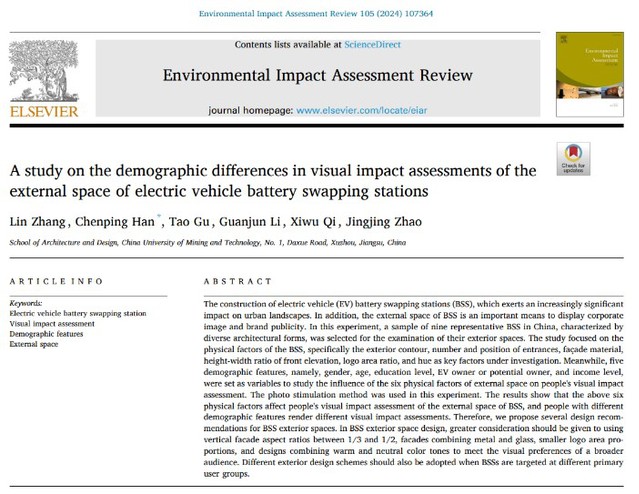

Recently, Prof. Han Chenping’s team from School of Architecture and Design published two high-level papers in Environmental Impact Assessment Review, an international authoritative journal in the field of sociological research, which is an SSCI Zone 1 TOP journal, and the titles of the papers published are “A study on visual impact assessment of the enclosing wall entourage of Chinese traditional private garden” and “A study on the demographic differences in visual impact assessments of the external space of electric vehicle battery swapping stations”. CUMT is the sole cosigner of the papers. Prof. Han Chenping is the corresponding author and the second author of the two papers. Yang Zhongju and Zhang Lin, graduate students of Class of 2021 of School of Architecture and Design, are the first authors of the two papers, respectively.
Classical Chinese gardens are one of the important sources of landscape art and design in the world, and are the treasures of Chinese culture, containing the veins and essence of Chinese civilization. As an important part of classical Chinese gardens, Chinese traditional private gardens, due to its unique artistic style and cultural interest, rich historical and traditional connotations and the pursuit of spiritual meaning, have been attracting attention from all circles at home and abroad, and the related research has been continuous and abundant. However, the research on “enclosing wall”, an important component of traditional Chinese private gardens, is still insufficient, and especially lacks new perspectives and new methods of combining qualitative and quantitative research using modern science and technology. To address this problem, Prof. Han Chenping’s team used digital image simulation, quantitative morphology analysis, visual perception experiments, mathematical and statistical analyses, etc., to investigate the visual perception of enclosing walls and their entourage by Chinese people of different genders, ages, and education levels. They revealed which specific landscape elements in the enclosing wall entourage have an impact on the visual perception of the Chinese people and their degree of impact, as well as the difference of relationship between Chinese people with different demographic characteristics and different landscape elements in the enclosing wall entourage. The research results provide an important reference for the inheritance and future development of Chinese classical garden and landscape culture.
With the popularization of electric vehicles, the construction of electric vehicle power exchange stations has been accelerating. With unique functions, power exchange stations carry the brand and image of enterprises, and influence urban space, and as a new type of building, they expand new fields for architectural design. Focusing on the design of the external space of electric vehicle power stations, Prof. Han Chenping’s team, analyzed and summarized the main features of the external space of nine representative electric vehicle power stations of eight electric vehicle manufacturers in China through systematic research and studied the visual preference of different groups of people through the quantification of the external space features of the buildings and the simulation of the stimulation of the images, etc. The study found the influence of the different features of the external space on the visual preference of different groups, the different preferences of different groups on the external building space of power stations, and the influence of different visual preferences on the willingness to consume electric vehicles. The research results provide useful references for the design of the external space of electric vehicle exchange station buildings, and also reveal the importance of consumer diversity in promoting the sales of electric vehicles. The research results of the external space design of electric vehicle power exchange station buildings, which Prof. Han Chenping was invited to present at the annual meeting of the Environmental Behavior Academic Committee of the Architectural Society of China in 2023, were highly evaluated by the experts attending the meeting, who believed that the research closely combines the theoretical research on environmental psychology and behavior with the practice of architectural design, and not only shows new thinking in the field of architecture on the development of the new industry of electric vehicles in China, but also provides a useful reference for responding to the new energy transportation industry.